Submissions: 2022 November
Re: Submissions: 2022 November
Andromeda in Hydrogen alpha
Credit: Andrea Bergamini and Sameer Bharadwaj
This is a blend of only 90 minutes of RGB color data with over 15 hours of Hydrogen alpha data. Goal was to bring out as much as possible both the hydrogen alpha emission nebulas in the 'foreground' coming from our own galaxy and the ones inside Andromeda itself.
Higher resolution and full acquisition details here: https://www.astrobin.com/tb60d2/
Thanks
Credit: Andrea Bergamini and Sameer Bharadwaj
This is a blend of only 90 minutes of RGB color data with over 15 hours of Hydrogen alpha data. Goal was to bring out as much as possible both the hydrogen alpha emission nebulas in the 'foreground' coming from our own galaxy and the ones inside Andromeda itself.
Higher resolution and full acquisition details here: https://www.astrobin.com/tb60d2/
Thanks
-
Herbert_Walter
- Ensign
- Posts: 18
- Joined: Sat Nov 05, 2022 2:56 pm
Re: Submissions: 2022 November
South of the star Antares in the nebula-rich constellation Scorpius lies the emission nebula IC 4628 - the Prawn Nebula.
This is a close-up of the central region. In the image field there are also 2 brilliant open clusters and more.
For object identification see: https://www.skypixels.at/ic4628_info.html
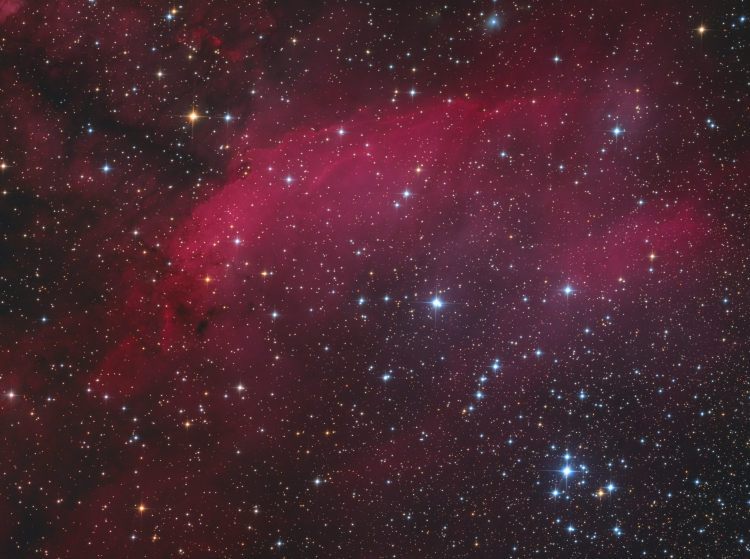
This is a close-up of the central region. In the image field there are also 2 brilliant open clusters and more.
For object identification see: https://www.skypixels.at/ic4628_info.html
Re: Submissions: 2022 November
Re: Submissions: 2022 November
NGC-1579 is a diffuse nebula located in the constellation of Perseus and also in the California Molecular Cloud.
I was able to get over 37 hours of imaging on this one and lightly processed in PixInSight. My goal was to bring out the dark dust in that surrounds the target.
Target: NGC-1579 The Northern Trifid Nebula
Imaging Telescope: Explore Scientific ED127 CF
Imaging Camera: ZWO ASI2600MM-Pro
Guide Scope: Explore Scientific ED127 CF
Guide Camera: ZWO 290mm-Mini
Mount: Sky Watcher EQ8-R Pro
Polar Alignment: ASIAir Plus
Bortle Class: 6
Filter: Chroma LRGB
55 x 600s (Lum)
55 x 600s (Red)
55 x 600s (Green)
55 x 600s (Blue)
Integration: PixInsight
15, 17, 18, 20 Nov 2022
Full Resolution: https://astrob.in/q6i9i2/0/
I was able to get over 37 hours of imaging on this one and lightly processed in PixInSight. My goal was to bring out the dark dust in that surrounds the target.
Target: NGC-1579 The Northern Trifid Nebula
Imaging Telescope: Explore Scientific ED127 CF
Imaging Camera: ZWO ASI2600MM-Pro
Guide Scope: Explore Scientific ED127 CF
Guide Camera: ZWO 290mm-Mini
Mount: Sky Watcher EQ8-R Pro
Polar Alignment: ASIAir Plus
Bortle Class: 6
Filter: Chroma LRGB
55 x 600s (Lum)
55 x 600s (Red)
55 x 600s (Green)
55 x 600s (Blue)
Integration: PixInsight
15, 17, 18, 20 Nov 2022
Full Resolution: https://astrob.in/q6i9i2/0/
-
martinkonrat
- Ensign
- Posts: 39
- Joined: Sun Sep 11, 2022 12:53 pm
Re: Submissions: 2022 November

The Horsehead Nebula (Barnard 33) and surroundings. OSC camera.
This image consists of a composition between a 7h integration image with an UV/IR filter and a 3.5h integration image with a Duo-Narrowband filter to pull some of the faint h-alpha details.
The blending process is always a trial and error quest until the sweet spot Is reached.
For my taste I find it beautiful to make those faint nebulosities around Alnilam to pop up, like IC426 For example.
There’s more to appreciate in this image than the obvious horsehead/flame/ngc2023 trio.
Image taken from november 15th to 17th (2022) in Giruá, south of Brazil. Bortle Scale 4.
Camera: asi2600mc
170 x 150s images with Optolong UV/IR filter
40 x 300s images with Antlia alp-t filter
Askar FRA400 refractor
Zwo AM5 mount.
Processing: Pixinsight, Photoshop.
Re: Submissions: 2022 November
Orion's treasures behind the observatory's Dome
Location : Cairo, Egypt
Kottamia Observatory is the largest telescope in the Middle East and North Africa. The telescope, which is located 80 km from the center of old Cairo, has a main mirror diameter of about 1.88 meters (74 inches) and weighs about 2 tons, The diameter of the dome is about 19 meters, and weighs more than 100 tons.
Light pollution is following us and Killing our observations, and in the upcoming few years the area around this observatory will be at 6-7 Bortle scale at least
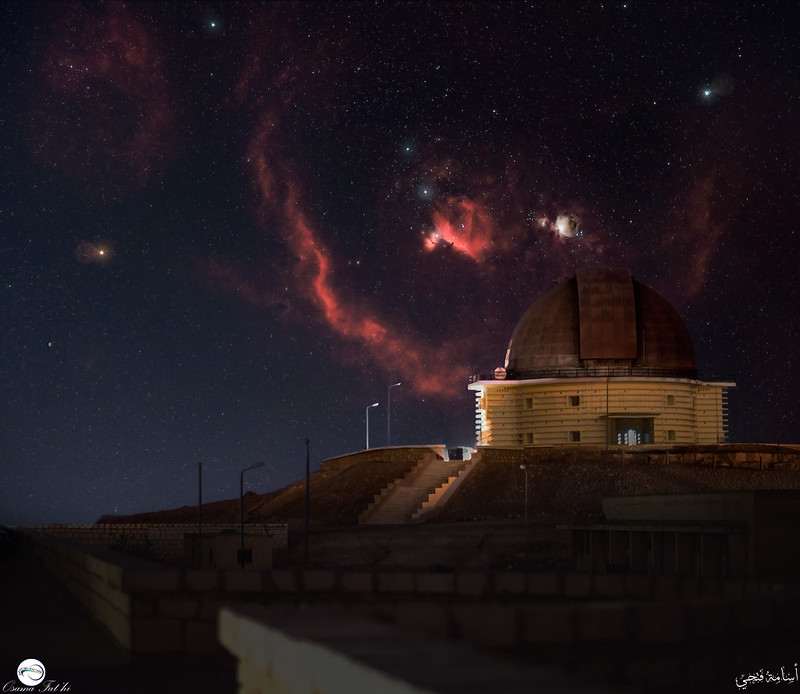 Red Ghost behind the Observatory by osama Fathi, on Flickr
Red Ghost behind the Observatory by osama Fathi, on Flickr
Gears:
Nikon z6 Mod, Skywacher staradventurer tracker , Samyang 85mm lens
Settings :
Sky (tracked stacked ): NBX dual filter 17*180 sec at ISO 4000 f3.5
foreground : 4 sec Iso 1250 f3.5
Softwares: DSS, Adobe Photoshop 2022, Pixinsight , Astrotools, Topaz DN
Osama Fathi
Social:
https://www.instagram.com/osama.fathi.nswatcher85/
https://www.facebook.com/NSWatcher/
Cairo, Egypt
Location : Cairo, Egypt
Kottamia Observatory is the largest telescope in the Middle East and North Africa. The telescope, which is located 80 km from the center of old Cairo, has a main mirror diameter of about 1.88 meters (74 inches) and weighs about 2 tons, The diameter of the dome is about 19 meters, and weighs more than 100 tons.
Light pollution is following us and Killing our observations, and in the upcoming few years the area around this observatory will be at 6-7 Bortle scale at least
 Red Ghost behind the Observatory by osama Fathi, on Flickr
Red Ghost behind the Observatory by osama Fathi, on FlickrGears:
Nikon z6 Mod, Skywacher staradventurer tracker , Samyang 85mm lens
Settings :
Sky (tracked stacked ): NBX dual filter 17*180 sec at ISO 4000 f3.5
foreground : 4 sec Iso 1250 f3.5
Softwares: DSS, Adobe Photoshop 2022, Pixinsight , Astrotools, Topaz DN
Osama Fathi
Social:
https://www.instagram.com/osama.fathi.nswatcher85/
https://www.facebook.com/NSWatcher/
Cairo, Egypt
-
mdieterich
- Science Officer
- Posts: 100
- Joined: Fri Feb 13, 2015 5:50 pm
Re: Submissions: 2022 November
The Helix Nebula
www.mattdieterich.com
Copyright: Matt Dieterich The Helix Nebula is a stunning deep sky target that was created as a result of a star near the end of it's life cycle expanding and shedding gas. The shells of expanding gas created the beautiful planetary nebula structure we can observe with telescopes. This evolution for the majority of stars in the Universe will also occur to our beloved Sun one day. I captured this 50-hour data set with a PlaneWave Instruments CDK600 at ObsTech using Voyager automation software. Camera used was a QHY600. HA = 43x30min, L = 177x5min, and RGB = 55x5min per channel.
www.mattdieterich.com
Copyright: Matt Dieterich The Helix Nebula is a stunning deep sky target that was created as a result of a star near the end of it's life cycle expanding and shedding gas. The shells of expanding gas created the beautiful planetary nebula structure we can observe with telescopes. This evolution for the majority of stars in the Universe will also occur to our beloved Sun one day. I captured this 50-hour data set with a PlaneWave Instruments CDK600 at ObsTech using Voyager automation software. Camera used was a QHY600. HA = 43x30min, L = 177x5min, and RGB = 55x5min per channel.
Re: Submissions: 2022 November
Barnard Loop in Orion Mosaic
Nikon Z6II modified + Nikon Z6II stock
Rokinon 135mm + Redcat 51
IDAS NGS1 + Optolong L-Pro
Fornax LighTrack II
Ioptron SGP
SWSA
13 Panels were used to integrate the mosaic in APP, Processed in PI and finished in PS. Cental Panel was 10 hrs integration of various exposure time from 5 seconds to 4 minutes.
27 hr + total integration
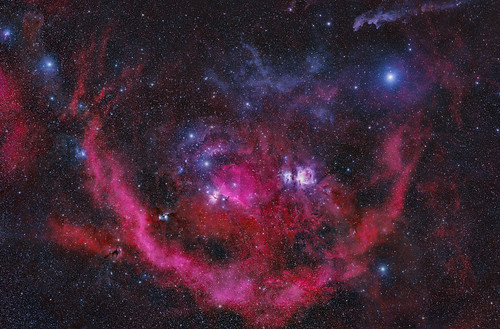 Barnard Loop in Orion by Ahmed Waddah, on Flickr
Barnard Loop in Orion by Ahmed Waddah, on Flickr
Facebook: https://www.facebook.com/waddah.photography
Astrobin: https://www.astrobin.com/users/WolfHeart/
IG: https://www.instagram.com/waddahphotography/
Nikon Z6II modified + Nikon Z6II stock
Rokinon 135mm + Redcat 51
IDAS NGS1 + Optolong L-Pro
Fornax LighTrack II
Ioptron SGP
SWSA
13 Panels were used to integrate the mosaic in APP, Processed in PI and finished in PS. Cental Panel was 10 hrs integration of various exposure time from 5 seconds to 4 minutes.
27 hr + total integration
 Barnard Loop in Orion by Ahmed Waddah, on Flickr
Barnard Loop in Orion by Ahmed Waddah, on FlickrFacebook: https://www.facebook.com/waddah.photography
Astrobin: https://www.astrobin.com/users/WolfHeart/
IG: https://www.instagram.com/waddahphotography/
Re: Submissions: 2022 November
Here is the CG4 area that I did from a set of 2 Advanced Requests through Telescope Live. I framed it in a way to also get NGC 2427. I've wanted to attempt this one since I first saw it a few years ago.
This was acquired via the Telescope Live CHI-2 setup, then processed in APP and Photoshop. It consists of 6x 300s each of RGB, 8x 300s of L, and 8x 600s of Ha, for a total of 3.5 hours of integration.
Full size image is here:
 CG4_marked by Scotty Bishop, on Flickr
CG4_marked by Scotty Bishop, on Flickr
This was acquired via the Telescope Live CHI-2 setup, then processed in APP and Photoshop. It consists of 6x 300s each of RGB, 8x 300s of L, and 8x 600s of Ha, for a total of 3.5 hours of integration.
Full size image is here:

 CG4_marked by Scotty Bishop, on Flickr
CG4_marked by Scotty Bishop, on Flickr-
Alson Wong
- Ensign
- Posts: 85
- Joined: Tue Sep 06, 2011 4:14 am
- Contact:
Re: Submissions: 2022 November
NGC 918 and Galactic Cirrus
Copyright: Alson Wong Spiral galaxy NGC 918. The wispy structures are areas of dust (galactic cirrus) which reflect the combined starlight from our galaxy.
Copyright: Alson Wong Spiral galaxy NGC 918. The wispy structures are areas of dust (galactic cirrus) which reflect the combined starlight from our galaxy.
Last edited by Alson Wong on Thu Nov 24, 2022 6:13 pm, edited 1 time in total.
-
ExplorerEGYWO
- Ensign
- Posts: 28
- Joined: Mon Jul 19, 2021 6:40 pm
Re: Submissions: 2022 November
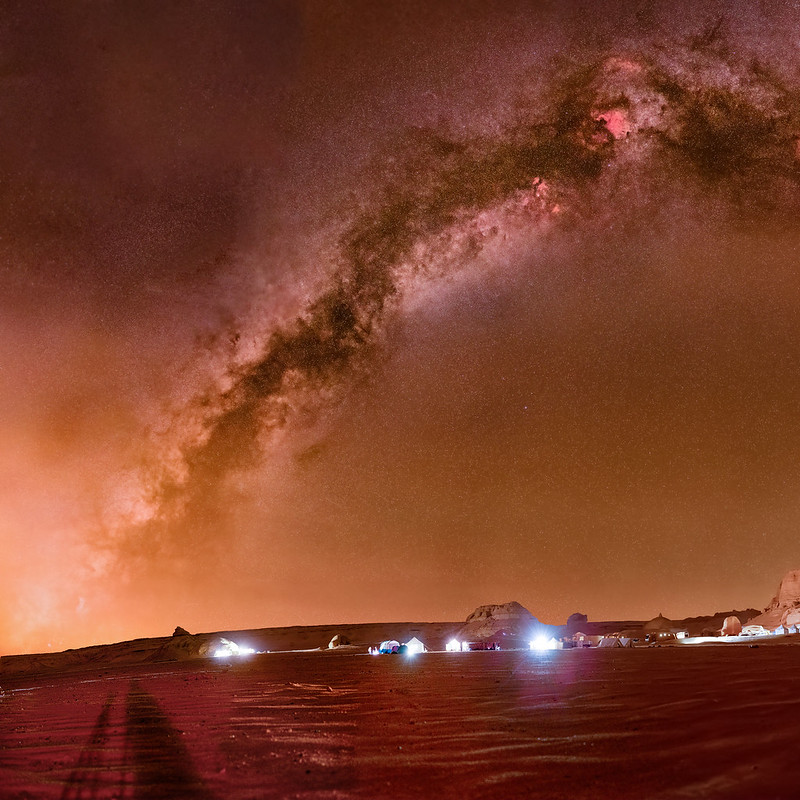 1 by Wael Omar, on Flickr
1 by Wael Omar, on Flickr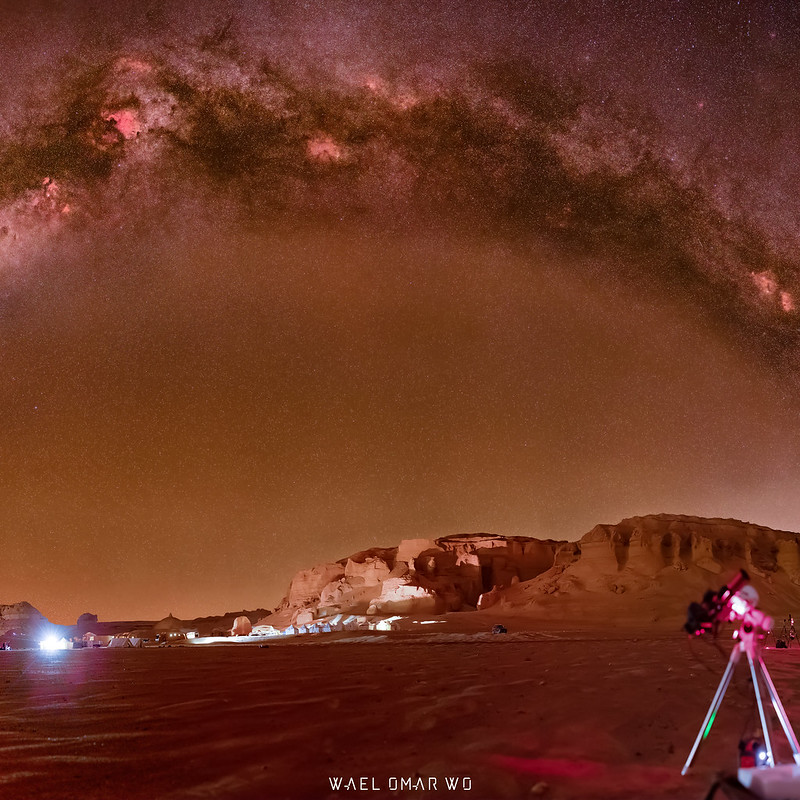 2 by Wael Omar, on Flickr
2 by Wael Omar, on Flickr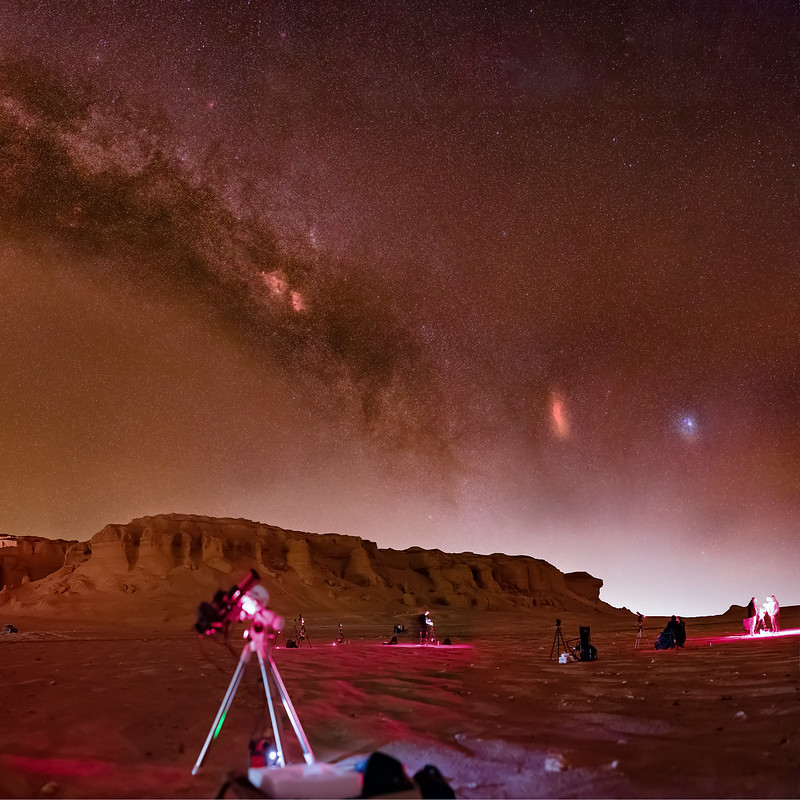 3 by Wael Omar, on Flickr
3 by Wael Omar, on Flickr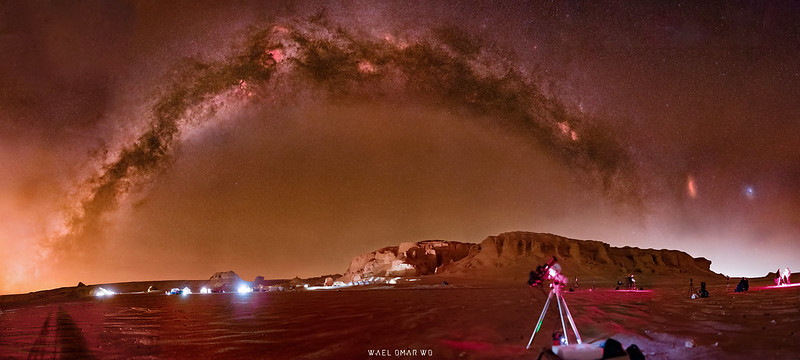 Ring of fire and Armestrong Shadow by Wael Omar, on Flickr
Ring of fire and Armestrong Shadow by Wael Omar, on FlickrMy Panorama image for Milky way taken in 18 th of November 2022 . I drove 5 hours away from home to Dark sky to be able to capture this image. The panorama is of 49 Panels . All images were taken about 90 minutes after sunset to be able to image a large part of the Milky way arc with Pleiades, California , North America ,Pelican , Elephant trunk , Heart ,Soul , Crescent nebulas and Sadr region. At the far right side you could see a group of EGYPTIAN astrophotographers deploying their gears to shoot the starry sky and to the far lower left side you could see my shadow with the tripod and it reminds me of Armstrong Shadow in the very famous image of Apollo 11 mission after landing on the moon. All images were shot by same gears in same place at same night.
Settings and Gears :
Camera : Sony A7 III Astro modified Ha with sigma FE 50mm F 1.4.
49 panels, ISO 3200, F 2 , 8 seconds.
Location : Wadi Elhitan , Fayoum ,EGYPT.
Credit: Wael Omar WO /https://www.instagram.com/waelomar_astrophotography/
-
mascha.samkova
- Asternaut
- Posts: 1
- Joined: Fri Nov 25, 2022 4:12 am
Re: Submissions: 2022 November
Dear Professor Robert J. Nemiroff, dear Professor Jerry T. Bonnell,
I hope you are both well.
By means of this email, I would like to submit an image for the NASA Astronomy Picture of the Day (APOD): https://flic.kr/p/2o2act6
The photo was taken on 13 December 2020, 07:35 am CET, on the Pont des Arts, overlooking the Pont Neuf and Ile de la Cite, 75006 Paris, France. The photo was taken before the sunrise, which was scheduled at 08:36 am on 13 December 2020.
I read and re read the NASA article "What's Up - December 2020", and from what Mr. Tony Greicius writes, I am extrapolating that in this photograph, I was able to magically capture 4 planets at once: Jupiter and Saturn (in the top left, closer in the sky than they have appeared in 2 decades) and the old crescent Moon and the planet Venus (on the top right).
Doing more background research I came across another photograph in the NASA Archive for Astronomy Picture of the Day listed on 14 November 2020, that is similar to mine, taken on 13 December 2020. It is the image labelled "Venus, Mercury and the Waning Moon": https://apod.nasa.gov/apod/ap201114.html
Is it possible that my photo, in the quality in which it is attached, could be enhanced?
Is it also possible that it could be labeled as "citizen science"?
Best regards,
Mascha Samkova
I hope you are both well.
By means of this email, I would like to submit an image for the NASA Astronomy Picture of the Day (APOD): https://flic.kr/p/2o2act6
The photo was taken on 13 December 2020, 07:35 am CET, on the Pont des Arts, overlooking the Pont Neuf and Ile de la Cite, 75006 Paris, France. The photo was taken before the sunrise, which was scheduled at 08:36 am on 13 December 2020.
I read and re read the NASA article "What's Up - December 2020", and from what Mr. Tony Greicius writes, I am extrapolating that in this photograph, I was able to magically capture 4 planets at once: Jupiter and Saturn (in the top left, closer in the sky than they have appeared in 2 decades) and the old crescent Moon and the planet Venus (on the top right).
Doing more background research I came across another photograph in the NASA Archive for Astronomy Picture of the Day listed on 14 November 2020, that is similar to mine, taken on 13 December 2020. It is the image labelled "Venus, Mercury and the Waning Moon": https://apod.nasa.gov/apod/ap201114.html
Is it possible that my photo, in the quality in which it is attached, could be enhanced?
Is it also possible that it could be labeled as "citizen science"?
Best regards,
Mascha Samkova
-
astrohokie
- Ensign
- Posts: 36
- Joined: Thu Oct 14, 2021 10:32 pm
Re: Submissions: 2022 November
Eastern Veil Nebula
https://www.flickr.com/photos/194543639@N07/
https://www.instagram.com/mark_hoffman_photography/
Copyright: Mark Hoffman, Instagram: @Mark_Hoffman_Photography
 by mark h, on Flickr
by mark h, on Flickr
 by mark h, on Flickr
by mark h, on Flickr
"The Veil Nebula is a cloud of heated and ionized gas and dust in the constellation Cygnus.
It constitutes the visible portions of the Cygnus Loop, a supernova remnant, many portions of which have acquired their own individual names and catalogue identifiers. The source supernova was a star 20 times more massive than the Sun which exploded between 10,000 and 20,000 years ago. At the time of explosion, the supernova would have appeared brighter than Venus in the sky, and visible in daytime. The remnants have since expanded to cover an area of the sky roughly 3 degrees in diameter (about 6 times the diameter, and 36 times the area, of the full Moon). While previous distance estimates have ranged from 1200 to 5800 light-years, a recent determination of 2400 light-years is based on direct astrometric measurements."
Equipment/Capture Details:
Eastern Veil Nebula (NGC 6992)
Celestron Edge HD8 w/ 0.7x reducer
EQ6R-Pro
Celestron Autofocuser
ZWO ASI 174MM
ASI 294MM Pro
ASI 7 position EFW
1.25in Chroma 5nm Ha, 3nm O3, 3nm S2 filters
Total Integration Time = 25 hours
Ha Integration Time = 81 * 600sec
O3 Integration Time = 69 * 600sec
Virginia, USA
Bortle 7
Capture dates: 10/21/2022, 10/27/2022, 10/282/2022, 10/29/2022, 11/13/2022, 11/17/2022, 11/20/2022, 11/22/2022, 11/23/2022, 11/24/2022
HOO palette using Pixel Math in Pixinsight with curves, saturation, deconvolution, StarXterminator, NoiseXterminator, then photoshop to turn red into orange.
https://www.flickr.com/photos/194543639@N07/
https://www.instagram.com/mark_hoffman_photography/
Copyright: Mark Hoffman, Instagram: @Mark_Hoffman_Photography
 by mark h, on Flickr
by mark h, on Flickr by mark h, on Flickr
by mark h, on Flickr"The Veil Nebula is a cloud of heated and ionized gas and dust in the constellation Cygnus.
It constitutes the visible portions of the Cygnus Loop, a supernova remnant, many portions of which have acquired their own individual names and catalogue identifiers. The source supernova was a star 20 times more massive than the Sun which exploded between 10,000 and 20,000 years ago. At the time of explosion, the supernova would have appeared brighter than Venus in the sky, and visible in daytime. The remnants have since expanded to cover an area of the sky roughly 3 degrees in diameter (about 6 times the diameter, and 36 times the area, of the full Moon). While previous distance estimates have ranged from 1200 to 5800 light-years, a recent determination of 2400 light-years is based on direct astrometric measurements."
Equipment/Capture Details:
Eastern Veil Nebula (NGC 6992)
Celestron Edge HD8 w/ 0.7x reducer
EQ6R-Pro
Celestron Autofocuser
ZWO ASI 174MM
ASI 294MM Pro
ASI 7 position EFW
1.25in Chroma 5nm Ha, 3nm O3, 3nm S2 filters
Total Integration Time = 25 hours
Ha Integration Time = 81 * 600sec
O3 Integration Time = 69 * 600sec
Virginia, USA
Bortle 7
Capture dates: 10/21/2022, 10/27/2022, 10/282/2022, 10/29/2022, 11/13/2022, 11/17/2022, 11/20/2022, 11/22/2022, 11/23/2022, 11/24/2022
HOO palette using Pixel Math in Pixinsight with curves, saturation, deconvolution, StarXterminator, NoiseXterminator, then photoshop to turn red into orange.
-
martinkonrat
- Ensign
- Posts: 39
- Joined: Sun Sep 11, 2022 12:53 pm
Re: Submissions: 2022 November
Portion of the Large Magellanic Cloud, NGC2020, NGC2014, NGC2040, NGC2032, etc.
The portrait features the giant nebula NGC 2014 and its neighbour NGC 2020, along with other NGC's,
which together form part of a vast star-forming region in the Large Magellanic Cloud,
a satellite galaxy of the Milky Way, approximately 163 000 light-years away.
🗓 November, 25th. 2022
 Giruá, RS, Brazil. Bortle 4.
Giruá, RS, Brazil. Bortle 4.
 FótonAstro 200mm f4 Newtonian Astrograph
FótonAstro 200mm f4 Newtonian Astrograph
 asi533mm
asi533mm
🕶 Antlia 4,5mm Oiii and Ha filters
Ha - 37 x 180s
Oiii - 57 x 180s
for a total of 4,7h integration.
 pixinsight, photoshop
pixinsight, photoshop
The portrait features the giant nebula NGC 2014 and its neighbour NGC 2020, along with other NGC's,
which together form part of a vast star-forming region in the Large Magellanic Cloud,
a satellite galaxy of the Milky Way, approximately 163 000 light-years away.
🗓 November, 25th. 2022
🕶 Antlia 4,5mm Oiii and Ha filters
Ha - 37 x 180s
Oiii - 57 x 180s
for a total of 4,7h integration.
Last edited by bystander on Sat Nov 26, 2022 5:10 pm, edited 1 time in total.
Reason: Please, no hot links to images > 500 kb. Uploaded image as an attachment.
Reason: Please, no hot links to images > 500 kb. Uploaded image as an attachment.
-
Herbert_Walter
- Ensign
- Posts: 18
- Joined: Sat Nov 05, 2022 2:56 pm
Re: Submissions: 2022 November
PGC 143 or WLM (it stands for Wolf–Lundmark–Melotte). This irregular dwarf galaxy is located 3 million light years away - just a little bit further away than the popular Andromeda galaxy - and shows clearly blue star clouds.
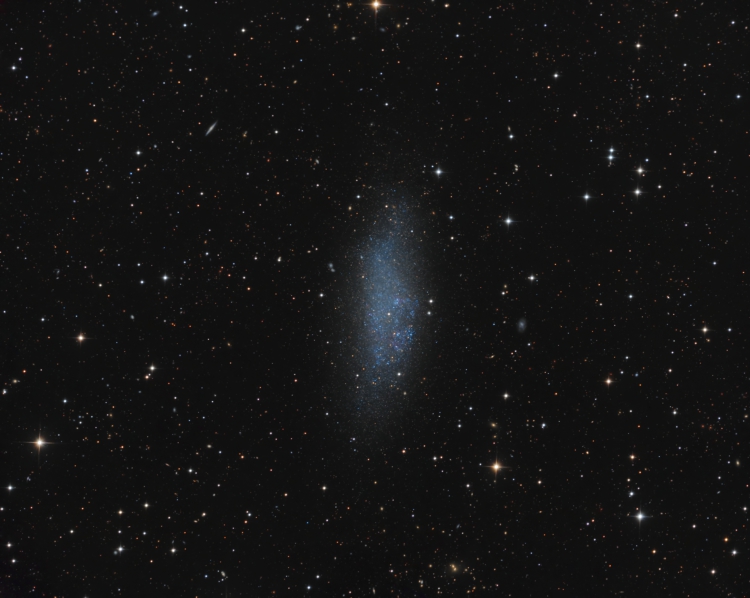
Re: Submissions: 2022 November
IC 4685
Click on above to enlarge.
Higher resolution and full iunfo @ https://www.kinchastro.com/ic-4685.html
Higher resolution and full iunfo @ https://www.kinchastro.com/ic-4685.html
-
Julien Looten
- Ensign
- Posts: 43
- Joined: Tue Mar 08, 2022 7:08 pm
Re: Submissions: 2022 November
The sky, between land and sea
flickr : https://www.flickr.com/photos/julienlooten/
Copyright: Julien Looten
This photograph was taken from the top of the Dune du Pilat (Gironde), looking west towards the Atlantic Ocean. Located between the Landes forest and the Arcachon basin, the Dune du Pilat is the highest dune in Europe..... Not easy to climb to the top at night with all the photographic equipment..... But the effort was worth it!
On a good part of the sky are visible "orange clouds"... ? This is called "airglow", a natural phenomenon caused by a chemical reaction in the upper atmosphere, where the sun's rays excite the molecules, which then emit a very weak light (chemiluminescence) of green or orange colour. This phenomenon can only be observed under a clear sky, free of light pollution, which is the case here towards the west, towards the ocean. Moreover, it is not or hardly visible on the left of the image, because of the light pollution of Biscarosse.
Beyond the Airglow and the Milky Way, we can see Jupiter (far left), and to its right Saturn, Altair and Vega. A nice alignment, especially since Jupiter, the largest planet in the solar system, was very bright (one month after its opposition).
On the left side of the image, you can see a part of the Landes de Gascogne forest. This forest was made infamous this summer because of a terrible fire that destroyed more than 20,000 hectares of nature... We become even more aware of the fragility of our small planet in the face of the immensity of the universe.
 : Panorama of 14 photos taken with a Canon 6d Astrodon (modified for astrophotography), and the Sigma 28mm f/1.4. Total exposure time 7minutes. November 13, 2022.
Thanks in advance
: Panorama of 14 photos taken with a Canon 6d Astrodon (modified for astrophotography), and the Sigma 28mm f/1.4. Total exposure time 7minutes. November 13, 2022.
Thanks in advance
full : https://www.flickr.com/photos/julienloo ... en-public/
instagram : https://www.instagram.com/j.looten/?hl=fr
Facebook : Julien.looten.photography
flickr : https://www.flickr.com/photos/julienlooten/
Copyright: Julien Looten
This photograph was taken from the top of the Dune du Pilat (Gironde), looking west towards the Atlantic Ocean. Located between the Landes forest and the Arcachon basin, the Dune du Pilat is the highest dune in Europe..... Not easy to climb to the top at night with all the photographic equipment..... But the effort was worth it!
On a good part of the sky are visible "orange clouds"... ? This is called "airglow", a natural phenomenon caused by a chemical reaction in the upper atmosphere, where the sun's rays excite the molecules, which then emit a very weak light (chemiluminescence) of green or orange colour. This phenomenon can only be observed under a clear sky, free of light pollution, which is the case here towards the west, towards the ocean. Moreover, it is not or hardly visible on the left of the image, because of the light pollution of Biscarosse.
Beyond the Airglow and the Milky Way, we can see Jupiter (far left), and to its right Saturn, Altair and Vega. A nice alignment, especially since Jupiter, the largest planet in the solar system, was very bright (one month after its opposition).
On the left side of the image, you can see a part of the Landes de Gascogne forest. This forest was made infamous this summer because of a terrible fire that destroyed more than 20,000 hectares of nature... We become even more aware of the fragility of our small planet in the face of the immensity of the universe.
full : https://www.flickr.com/photos/julienloo ... en-public/
instagram : https://www.instagram.com/j.looten/?hl=fr
Facebook : Julien.looten.photography
Re: Submissions: 2022 November
At the beginning of 2022 I left in the Cantal France (800km A / R only place where the weather was nice) to image on 2nights the constellation of Orion at 135mm, the first treatment was a little too artistic, so with Philippe Bernhard, during the astronomy weekend with the association and with the bad weather it gave us time to start all over again!
Full version https://astrob.in/5i5vmf/0/
Technical details
Samyang 135mm f2.8
Canon 6D Iso 1600
4 panels x 100 images x 120 seconds per exposure

https://astrob.in/5i5vmf/0/rawthumb/hd/get.jpg?insecure
Full version https://astrob.in/5i5vmf/0/
Technical details
Samyang 135mm f2.8
Canon 6D Iso 1600
4 panels x 100 images x 120 seconds per exposure

https://astrob.in/5i5vmf/0/rawthumb/hd/get.jpg?insecure
Last edited by bystander on Sun Nov 27, 2022 3:47 pm, edited 1 time in total.
Reason: Please, no hot links to images > 500 kb. Substituted smaller image.
Reason: Please, no hot links to images > 500 kb. Substituted smaller image.
-
ChrisKotsiopoulos
- Ensign
- Posts: 70
- Joined: Mon Mar 15, 2010 2:23 pm
Re: Submissions: 2022 November
Messier 91 – NGC 4548 - HST
Messier 91 (also known as NGC 4548 or M91) is a barred spiral galaxy found south of Coma Berenices. It is in the local supercluster and is part of the Virgo Cluster of galaxies. It is about 63 million light-years away from our galaxy. It was the last of a group of eight “nebulae” – the term ‘galaxy’ only came into use for these objects once it was realized in the 20th century that they were extragalactic – discovered by Charles Messier in 1781. It is the faintest object in the Messier catalogue.
Several hours post process.
Software:
FITS Liberator
Photomatix Pro 6.3
Photoshop CS5
More info:
https://en.wikipedia.org/wiki/Messier_91
Messier 91 (also known as NGC 4548 or M91) is a barred spiral galaxy found south of Coma Berenices. It is in the local supercluster and is part of the Virgo Cluster of galaxies. It is about 63 million light-years away from our galaxy. It was the last of a group of eight “nebulae” – the term ‘galaxy’ only came into use for these objects once it was realized in the 20th century that they were extragalactic – discovered by Charles Messier in 1781. It is the faintest object in the Messier catalogue.
Several hours post process.
Software:
FITS Liberator
Photomatix Pro 6.3
Photoshop CS5
More info:
https://en.wikipedia.org/wiki/Messier_91
-
Mauro Rorato
- Ensign
- Posts: 15
- Joined: Tue Jan 20, 2015 9:07 am
Re: Submissions: 2022 November
IC 434 is an emission nebula visible in the constellation Orion; thanks to its presence it is possible to observe the famous Horsehead Nebula, a dark cloud that overlaps it on our line of sight.
At the bottom left we find NGC 2023, a small nebula that shines by reflection of the light produced by the star HD 37903, of spectral class B5, from which it takes its markedly bluish color; this is the southernmost illuminated part of Orion B.
At the top left enters the blue light of the star Alnitak, one of the three stars in Orion's belt
Mauro
https://themaurosky.wixsite.com/astroph ... di-cavallo https://static.wixstatic.com/media/d3e3 ... c3~mv2.png
At the bottom left we find NGC 2023, a small nebula that shines by reflection of the light produced by the star HD 37903, of spectral class B5, from which it takes its markedly bluish color; this is the southernmost illuminated part of Orion B.
At the top left enters the blue light of the star Alnitak, one of the three stars in Orion's belt
Mauro
https://themaurosky.wixsite.com/astroph ... di-cavallo https://static.wixstatic.com/media/d3e3 ... c3~mv2.png
Last edited by bystander on Sun Nov 27, 2022 5:19 pm, edited 1 time in total.
Reason: Please, no hot links to images > 500 kb. Uploaded image as an attachment.
Reason: Please, no hot links to images > 500 kb. Uploaded image as an attachment.
-
maphilli14
- Ensign
- Posts: 35
- Joined: Tue May 08, 2012 2:32 am
Re: Submissions: 2022 November
Mars with Phobos and Deimos!
https://astromikephillips.wixsite.com/home
Copyright: Michael A. Phillips
https://i.imgur.com/ni9bWoU.png
https://astromikephillips.wixsite.com/home
Copyright: Michael A. Phillips
https://i.imgur.com/ni9bWoU.png
Last edited by bystander on Mon Nov 28, 2022 12:25 am, edited 1 time in total.
Reason: Please, no hot links to images > 500 kb.
Reason: Please, no hot links to images > 500 kb.
-
jason.doyle.sr
- Asternaut
- Posts: 1
- Joined: Sat Sep 18, 2021 1:11 pm
Re: Submissions: 2022 November
The Golden State in Perseus
California Nebula - SHO with RGB stars
I imaged this nebula on four consecutive clear nights, Nov 19-22, from my home in Maryland.
Captured with NINA, stacked in APP, processed in Photoshop.
Sky-Watcher Esprit 100, QHY 268M
Chroma H-alpha 3nm: 171×180″ (8h 33m)
Chroma OIII 3nm: 334×180″ (16h 42m)
Chroma SII 3nm: 157×180″ (7h 51m)
Antlia RGB: 270x10" (45m)
Total exposure time is 33hrs, 51min
https://www.flickr.com/photos/70831900@N04/52527619014/
https://www.astrobin.com/835p12/H/
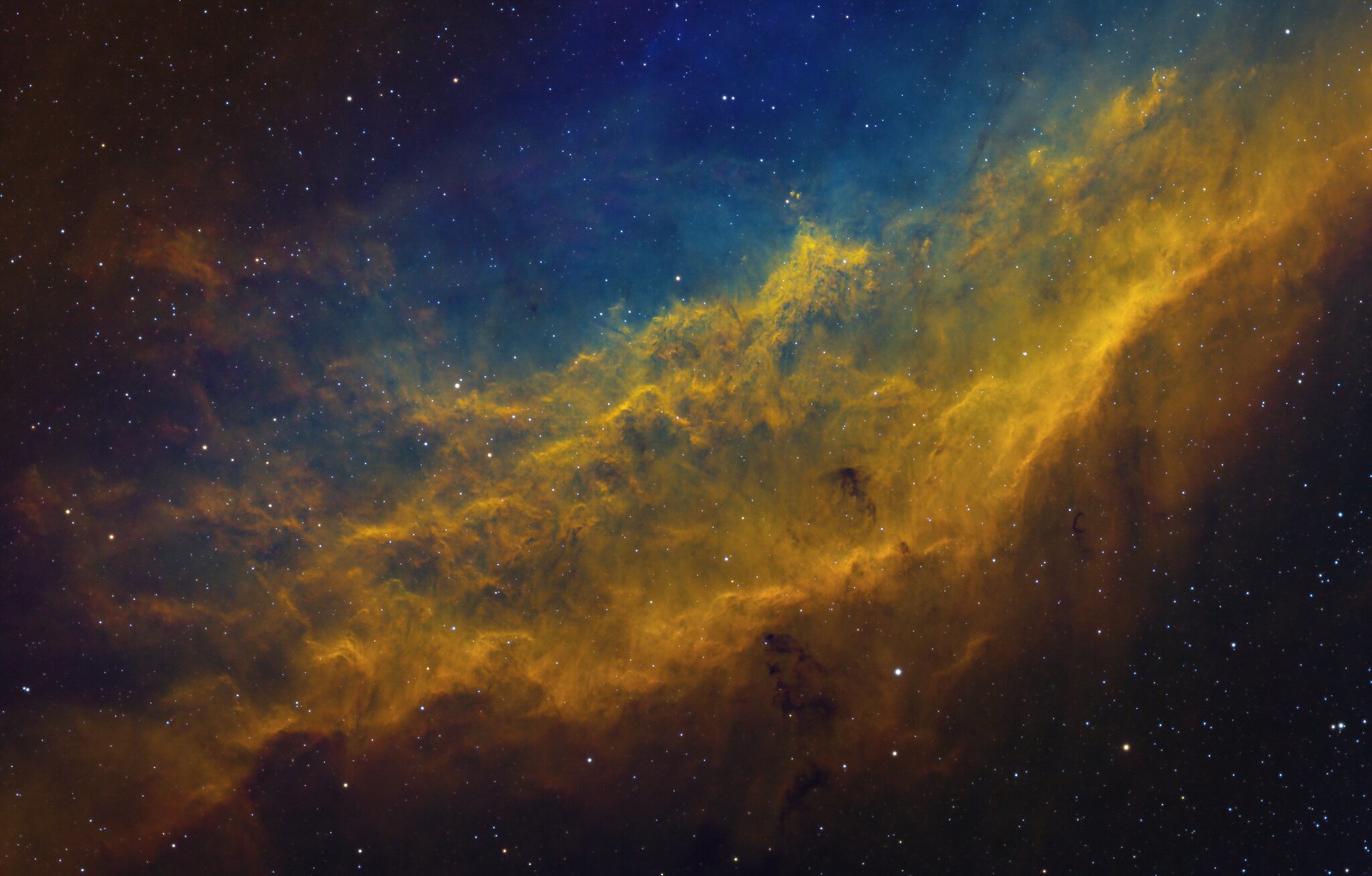
California Nebula - SHO with RGB stars
I imaged this nebula on four consecutive clear nights, Nov 19-22, from my home in Maryland.
Captured with NINA, stacked in APP, processed in Photoshop.
Sky-Watcher Esprit 100, QHY 268M
Chroma H-alpha 3nm: 171×180″ (8h 33m)
Chroma OIII 3nm: 334×180″ (16h 42m)
Chroma SII 3nm: 157×180″ (7h 51m)
Antlia RGB: 270x10" (45m)
Total exposure time is 33hrs, 51min
https://www.flickr.com/photos/70831900@N04/52527619014/
https://www.astrobin.com/835p12/H/

-
H-alpha
Re: Submissions: 2022 November
Full map and Animated rotation of Mars, 27 Oct to 25 Nov 2022
As we are approaching to Mars opposition in three days, I have the pleasure to share with you the FULL MAP of Mars and animation of its full rotation. The map and animation are composed by 15 captures acquired from the end of last October (27) to 25 November 2022. All captures were made from Vouliagmeni, south suburbs of Athens, Greece.
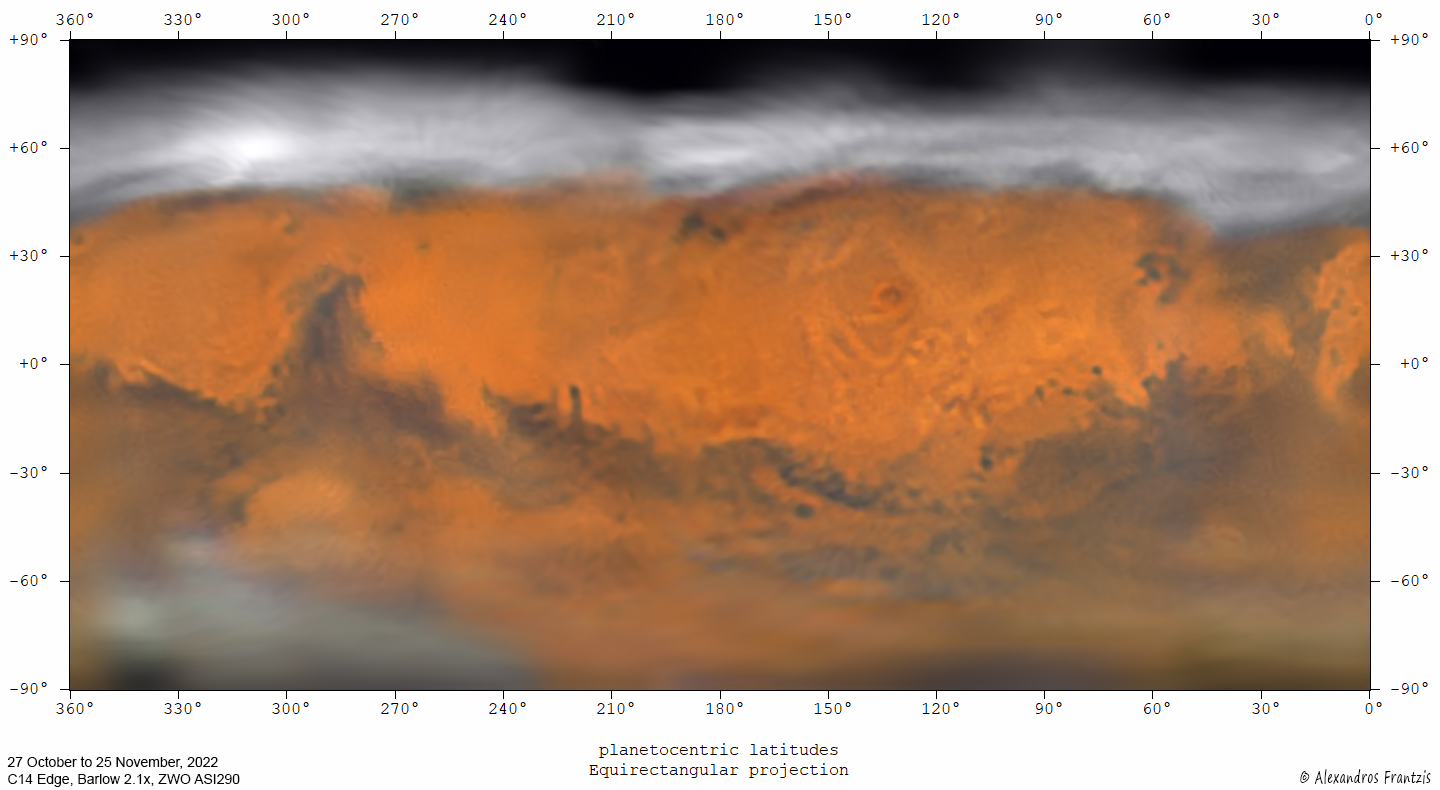
To see the map in higher resolution, please click on the following link:
https://live.staticflickr.com/65535/525 ... 0763_o.jpg
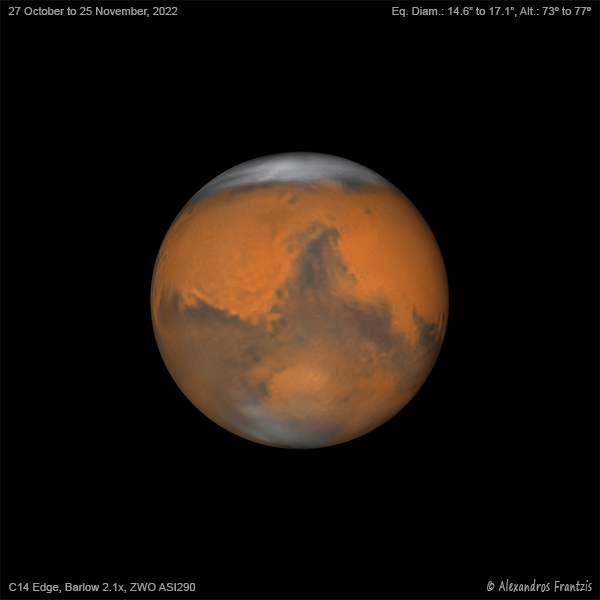
The above is just a thumbnail. To watch the animation of the rotating Mars, please click on one of the following links:
https://live.staticflickr.com/65535/525 ... 490e_o.gif
https://www.cloudynights.com/uploads/ga ... 905741.gif
Best wishes,
Alexandros
As we are approaching to Mars opposition in three days, I have the pleasure to share with you the FULL MAP of Mars and animation of its full rotation. The map and animation are composed by 15 captures acquired from the end of last October (27) to 25 November 2022. All captures were made from Vouliagmeni, south suburbs of Athens, Greece.

To see the map in higher resolution, please click on the following link:
https://live.staticflickr.com/65535/525 ... 0763_o.jpg

The above is just a thumbnail. To watch the animation of the rotating Mars, please click on one of the following links:
https://live.staticflickr.com/65535/525 ... 490e_o.gif
https://www.cloudynights.com/uploads/ga ... 905741.gif
Best wishes,
Alexandros
Re: Submissions: 2022 November
Barnard 10
Barnard 10 is a Dark Nebula appearing in the constellation Taurus.
High resolution Link and acquisition details: https://www.astrobin.com/6ngjp3/0/
Credit and Copyright: Massimiliano Peri
Barnard 10 is a Dark Nebula appearing in the constellation Taurus.
High resolution Link and acquisition details: https://www.astrobin.com/6ngjp3/0/
Credit and Copyright: Massimiliano Peri
Last edited by max.peri on Mon Nov 28, 2022 9:42 pm, edited 1 time in total.





